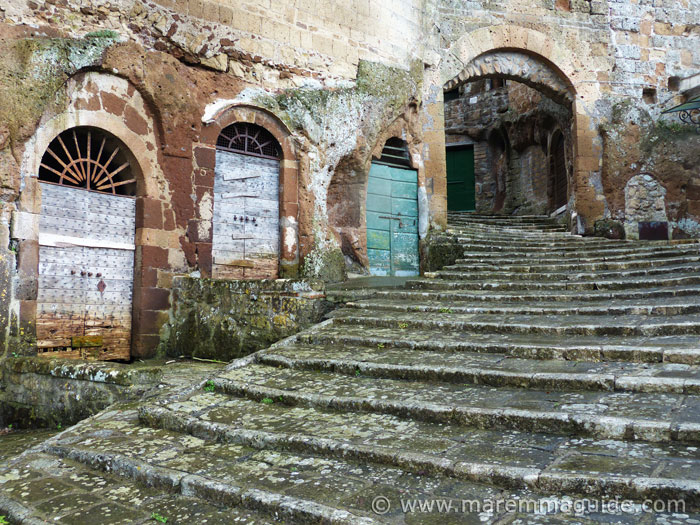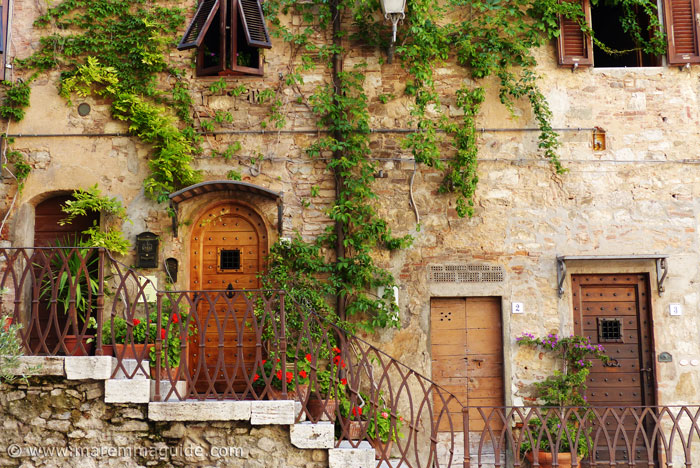Places to visit in Maremma Italy
Places to visit in Maremma Italy: this is Tuscany off the beaten track and some! Many aren't the kind of places that invite tomes and guides to be written about them, yet many will have reams and reams of scientific papers and ongoing research to their name.
They won't ever feature in most guidebooks, yet mention their name to anyone living in Maremma and the knowing nod and smiles will tell you all.
They are special places loved for being just what they are, no advertisements needed. Together they make Maremma what it is and it is nothing like the Tuscany you will have been expecting.
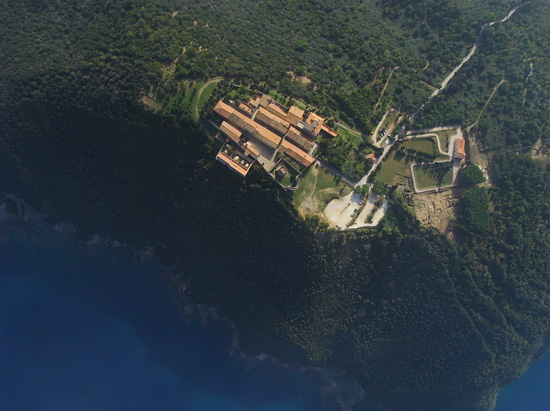 Photo by kind permission of Opaxir
Photo by kind permission of Opaxir
A BIG note! All of hill top medieval castles, forts, coastal look-out towers, hill top towns, and gorgeous beaches are on other pages.
And I know that, even if they have the advantages of never having an entrance queue or a tacky souvenir stall in sight, they won't appeal to everyone. At least not on many people's first trip to Tuscany.
But when the beauty of the city of Florence has been seen and admired. When the Uffizzi Gallery has left you with your head spinnin. The Leaning Tower of Pisa climbed. And Siena and its stunning piazza and the towers of San Gimignano, and more, sat in and photographed. They will be the places that touch your heart in a more profound way and light your face with a smile.
For lovers of history, the outdoors, nature, and the little things in life that special memories are made of, Maremma is waiting to be discovered.
Etruscan mysteries
Maremma is nothing short of an open-air Etruscan museum in which its treasures are presented to you even as you make your way down to a cove for a day at the beach. Discovering history in such a way, especially with young children, doesn't get any better than that.
The Etruscans were a rich and incredibly important civilization in this part of Italy. Although their cities and communities succumbed to Roman rule and were lost forever, their rich mining and forging activities, agricultural drainage, sea and road transport infrastructures, determined much of what you can see in Maremma today. Indeed, it is not by chance that the whole of the northern coast of Maremma and beyond into northern Tuscany is called the Costa degli Etruschi - Etruscan Coast.

Abandoned or built upon they may have been, but you cannot walk far in Maremma and not come across evidence of an Etruscan town, village, necropolis or row upon row of tombs.
Take a walk under the canopy of one of Maremma's many wooded hills escape the heat of the summer sun and what would have at first seemed a simple "bosco" (wood) will reveal itself to be the home of an old Etruscan mineral excavation area, with houses and a forge, or a stone "cava" (quarry) with tombs built into the exhausted rock face.
The Vie Cave at Pitigliano, Sovana and Sorano
Words sometimes don't come close to describing experiences in Maremma. Pictures help, as do videos (and I have included those too), but still they fall short of sharing what a place is really like when you step into it. And Maremma's Etruscan Vie Cave are those kind of places.
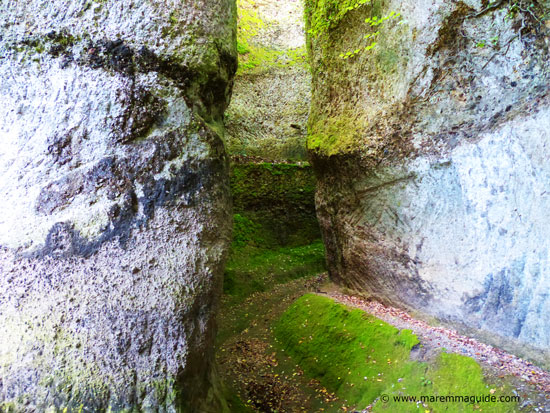
Step inside them and walk past the spider filled caves in their sides for a spooky shiver down your spine whilst you search for a place for your next foot step in puddled holes and on on slippery green moss and lichen covered rock. All the while looking up at the sky between the tree canopy high above you contemplating how and why they were built.
For a memorable experience filled with mystery, take a walk through one of the "Vie Cave" or "Cavoni" that radiate from the tufo city of Pitigliano and lead to the nearby towns of Sovana and Sorano. Fifteen, deep and in places dark, passages up to 25 metres in height, chiseled out of the tufo rock by the Etruscans that lived here. No other civilisation has ever made anything similar.
Some connect Pitigliano with the beautiful Necropolis and monumental tombs at Sovana, others have tombs and caves along their route, but their purpose is still debated and a mystery. A defense system against invaders, a quarry system, or sunken passages symbolic of the journey to the after life?
The Vie Cave at Sovana
There is even one called the "Devil's Road'! The Vie Cave at Sovana.
Can you spot the couple stood not far from me along the road?
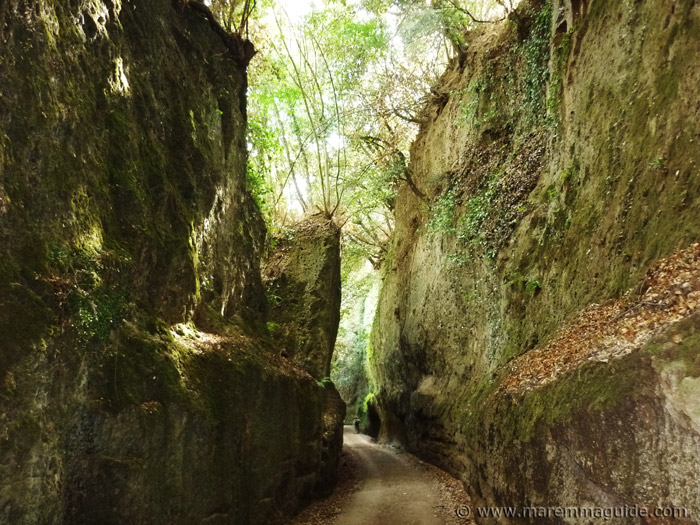
The Vie Cave at Sorano
If you want a whole day out in the outdoors trekking and exploring, then the Via Cava di San Rocco at Sorano is for you. Because.

At about 6 kilometres long (the route is not all carved deep into the local tufa rock) it will take you from an incredible panoramic view of the tufa town of Sorano. One of my favourite places in the whole of Tuscany. A spooky face that will see you before you see it! And caves. At the Insediamento Rupestre di San Rocco.
Down one side of a gorge and across a bridge over the River Lente. A glass bridge, but in name only! For it is called the "Ponte del Bicchiere" - the bridge of the glass.
Across an aqueduct, past a pond and waterfall, to another cave. This time one that is home to the source of the river.
And then up through woodland and Mediterranean macchia to the top of the other side of the gorge. Carved into which you will find one of Italy's oldest rock settlements. And on top it's castles and churches. The lost city of Vitozza.
Spine-tingling spooks in Sorano - the Insediamento Rupestre di San Rocco
Appearances can be deceptive.
For some it will always be just a picnic site clearing in a copse with a panoramic view. A tiny, boring looking church, whose door is never open. And some holes in some rocks.
But for others. Well, for others it will be the door to a world eight centuries before Christ. Of wolves and walking on fire.
The Insediamento Rupestre di San Rocco at Sorano. Go visit and be spooked! And then eat your picnic!

The Etruscan tombs
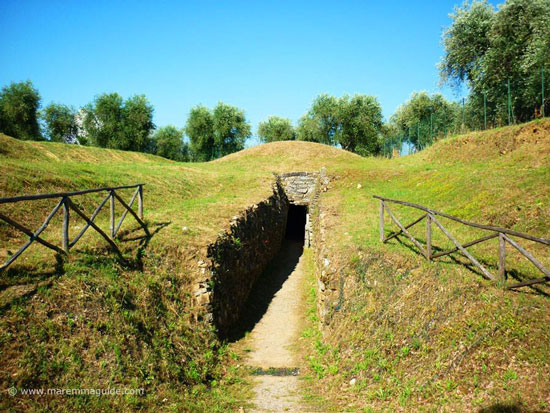
The treasure tomb found in 1882 and three others down a country lane in Vetulonia, Tuscany for an Indiana Jones experience: a great one for the kids and free entry is free.
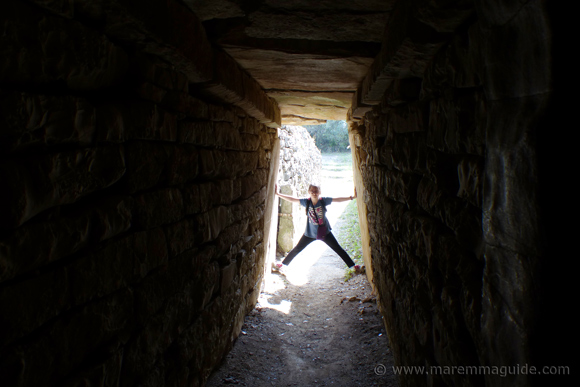
The Etruscan trench and tumulus tombs at the beautiful freshwater lake of Lago dell'Acessa including that of an aristocratic couple whose burial finds included silver jewellery and a large number of still intact Etruscan-Corinthian perfume flasks. You can even take a swim in the lakes crystal clear waters whilst you are there.
The only Etruscan city built by the sea
Also inhabited in neolithic times, Populonia, sat on cliffs at the highest point of the Monte Massoncello peninsular, is where the Etruscan civilisation decided to build its only city by the sea. And the city was an important and wealthy one.
Visit the Parco Archeologico di Baratti e Populonia that takes you from the acropoli in Populonia to the necropoli in the Gulf of Baratti with Etruscan tombs, a monumental tumulus, shrine and sarcophagus, sites of metal-working, the ancient walls of Populonia, old quarries, burials dug into solid rock, the Benedictine monastery of San Quirico... and more. Along trails with spectacular panoramic views of the Maremma coastline.
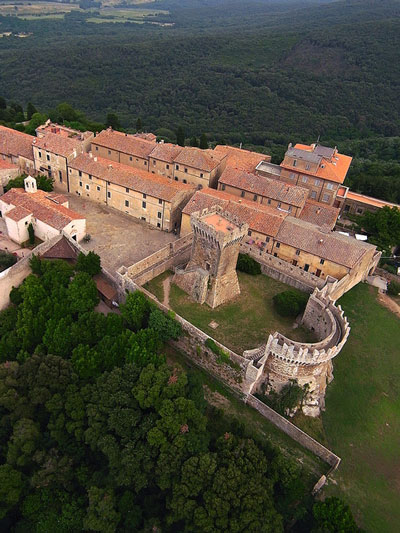
The kite aerial photograph taken by Opaxir at the top of this page is a spectacular view of Populonia today: a pretty little medieval village enclosed within a fifteenth century fortress.
Roman spas and a tiny amphitheatre
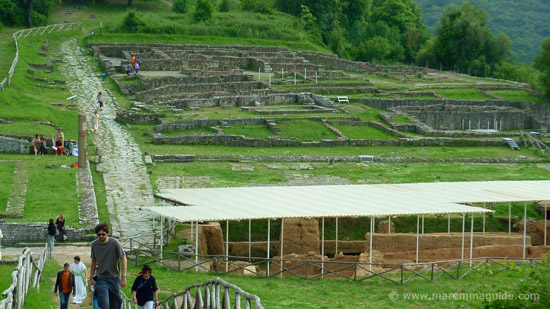
One of the most important archaeological areas in the whole of Italy: first a prehistoric settlement and the ancient Etruscan city of Rusellae on the shores of a lake, the Romans came and loved it too, building a haven of relaxation with a complex of hot, cold, tepid and steam therme baths.
You can easily spend a whole morning or afternoon exploring the remains of both the Etruscan and Roman cities enclosed within an magnificent seven metres high cyclopean wall whose skilled engineering leaves you with a sense of awe. And then there is the tiny Roman amphitheatre, mosaics, forum, basilica and.. Take a look from the air: Parco Archeologico di Roselle.
Hot rocks, smelly vapours and fantastic views
Parco Geotermico delle Biancane

If the thought of walking upon hot rocks within an extraordinary colour palette of a landscape intrigues you, then a visit to the geothermal landscape of Le Biancane at Monterotondo Marittima and in the valley of the devil! at Sasso Pisano won't disappoint.
Perfect exploration grounds for budding geologists and children with a fascination for how the earth works, as well as a heaven for landscape photographers. All free. You just have to become immune to the smell of rotten eggs!
Marvellous mudpots!
Caused by the combination of superheated waters, sulphurous gases and some of the oldest micro-organisms on earth, this little treasure can be found alongside a geothermal lake called the Lago Boracifero and the worlds first geothermal energy plant.

Maremma's nature reserves, parks and more
The most well known Maremma park is that of the Parco Regionale della Maremma; and it is very beautiful and definitely a must place to visit.
But what will probably be unnoticed, unless you spend some time driving across this part of Tuscany and your eye starts to spot the road sign - one at first, then another and another - or, if you have a detailed map laid out before you, is that the majority of Maremma is a regional park, wildlife reserve, WWF oasis, site of special interest or international reserve.
Choose a farmhouse to stay in and you will likely be sleeping in the midst of one.
Some of my favourites...
La Riserva Naturale Diaccia Botrona
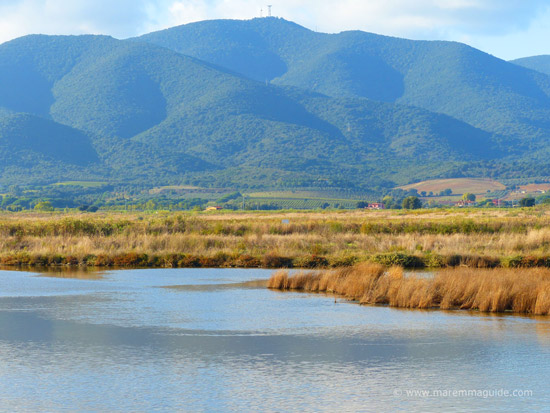
One of the most important wetlands in the world and a birders heaven, the only thing that disturbs the tranquility in this sound of fish frolicking in the canals and marsh pools, which they do a lot! There's a boat tour too if you haven't packed your wellies (after all who does for a vacation in Tuscany!) but would love to do a spot of birdwatching (or wild boar swimming come to that) close enough to see the resident pink flamingoes.
The Riserva Naturale Diaccia Botrona. A lovely place anytime of the year.
Il Padule di Scarlino

For a stroll through a wetland reserve where you don't even need to wear waterproof boots or shoes, where you can spot horned Maremmano cattle, a Copypu or two (and their poo!), lots of scampering tiny green lizards, a multitude of different and brilliantly coloured dragonflies, and nearly two hundred different species of birds. As well as a wild boar or two if you are lucky. All just two minutes from a great beach.
The Oasi del Padule di Scarlino.
The Riserva Naturale della Laguna di Orbetello

The WWF Riserva Naturale ed Oasi della Laguna di Orbetello - better known as the Laguna di Orbetello - is the largest wetland along the whole of the Tyrrhenian coast and a special and favourite location for some serious bird watchers and photographers alike. Visit during the autumn or winter, when the lagoon is home to large numbers of migratory wading birds, and you won't be able to stop filling your camera card with splash after splash of pink and white: more than four thousand pink Flamingoes and two hundred Spoonbills :)
But you don't need to be a birdwatcher to spend a great few hours here because lots of other tiny creatures also like to steal a piece of the limelight from time to time! The type that bring smiles to little ones (and adults too!) faces.
The Parco Costiero della Sterpaia

A landscape, seascape, wildlife, plantlife, and sunset photographers dream. With ten kilometres of sandy beaches perfect for kids to play away on for hours and hours (with all the facilities a mum will need close at hand), as well as a magical woodland and waterways home to shy Nutria, frogs, toads and turtles...
The Parco Costiero della Sterpaia is a wonderful place to visit in Maremma anytime of the year, but especially in the spring, autumn and winter when you can have whole stretches of Maremma's coast all to yourselves.
The Parco Naturale di Montioni
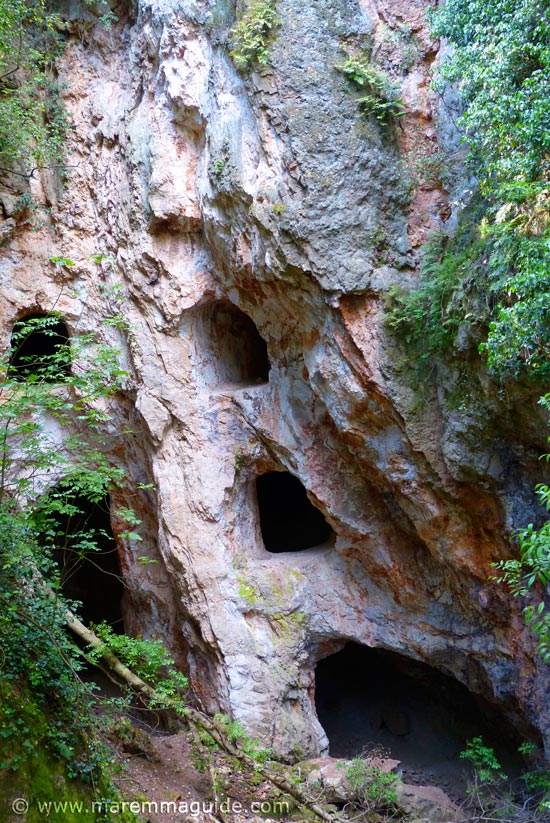
A haven for archaeologists, historians, geologists, wildlife photographers, walkers, mountain bikers, and lovers of rare plants... to name just a few, this nature park is one of my favourite locations for a Sunday ramble.
Here I can walk in the footsteps of Neanderthal, Etruscan, Roman, and medieval man, as well a French princess and wolves, all at the same time! You just have to keep your eyes peeled as you make your way through the trees to spot the signs and footprints!
And if you really keep your eyes open, you might even be lucky enough to find a lost medieval village :) Now wouldn't that make for an unforgetable holiday memory and even perhaps a little fame in Tuscany!
But that's not all. Today, the park is also home to something very rare on our planet. When a wood isn't just a wood then, but the Parco Naturale di Montioni.
And. Then there is.
Maremma's lost ocean
The Parco di Punta Falcone, in Piombino.
You are going to have to trust me about this nature reserve. Especially the closer you get. In order to stand on a long lost ocean.
The only place in the world where you can.
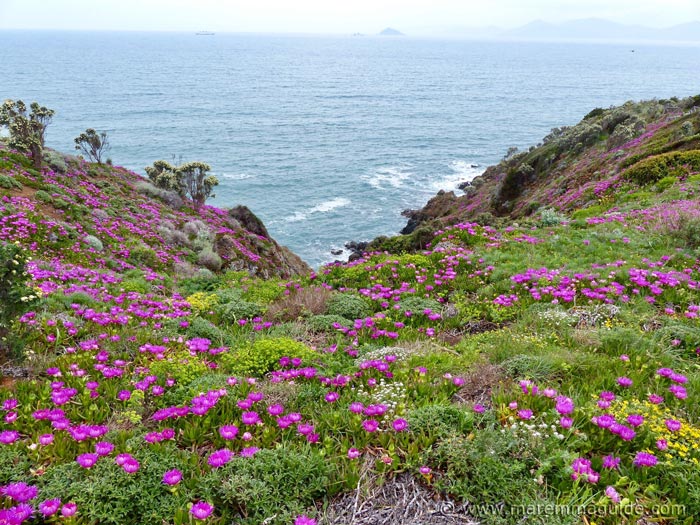
The Punta Falcone nature park.
Historical Ruins
The Monastery of San Bruzio
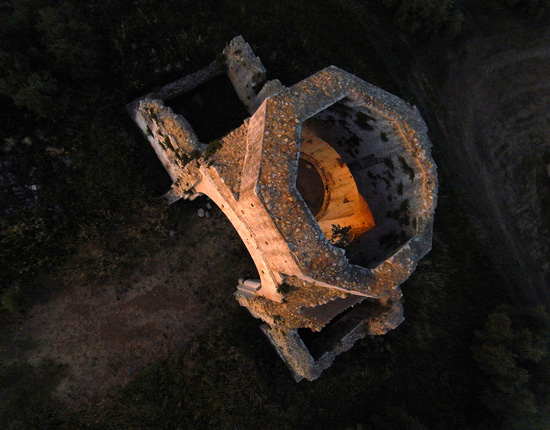 KAP photo by kind permission of Opaxir
KAP photo by kind permission of Opaxir
Very little is known about the origins of the Monastero di San Bruzio and today there remains only a ruin of its fine structure nestled amongst corn fields and olive trees.
But its location just outside Magliano in Toscana is a beautiful and peaceful spot in which to just sit and relax. A visit will capture your imagination and leave you wondering what kind of life existed within its walls in eleventh century Maremma. A special place to visit in Tuscany, no bells and whistles, just special.
The hidden crypt of the Abbazia di San Salvatore di Giungano

If you go down to the woods today. You're sure of a big surprise...
Climb the metal ladder down under an ancient oak wood into a hidden 11th century Tuscany crypt that very few people know exists and be captivated by the mystery of its history and subterranean treasures. The Abbey of San Salvatore di Giugnano.
Isola Clodia and the Abbey of St. Pancrazio al Fango

A once upon a time island and the ruins of an abbey built on top of a Roman villa above a huge lake in Maremma that is no more: Isola Clodia. A great location for a view of the marshes and thick wooded foothill landscape near the coast of Castiglione della Pescaia.
Maremma's Museums
Maremma's museums are full of treasures and mysteries and things to fascinate everyone. Not just on a rainy day.
Where everything that glitters is gold: Vetulonia's Etruscan museum
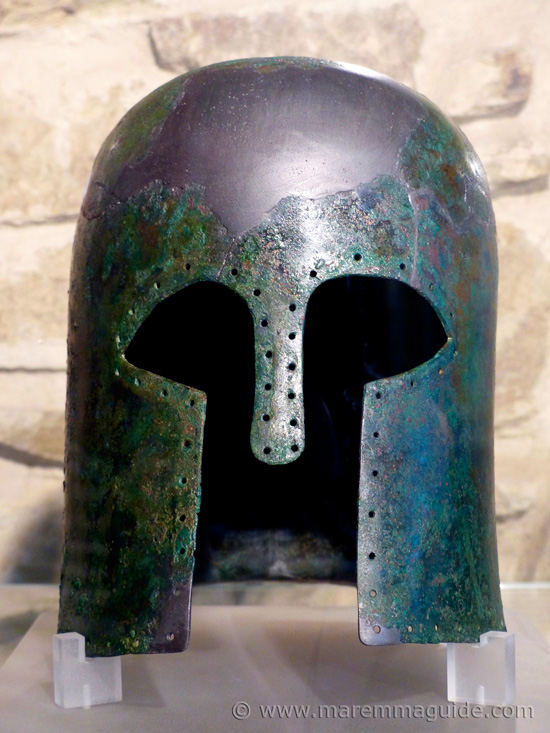
This small country museum is jammed-full of tiny and big treasure.
From thirty centuries ago.
Things that the tomb raiders of the 18th and 19th centuries didn't find. Things that Vetulonia, a city lost for 700 years. A city of gold. Kept hidden. Waiting for the hands of those who would love them with a passion that had nothing to do with money.
Don't miss it. It is full of wonder.
Massa Marittima Mining Museum
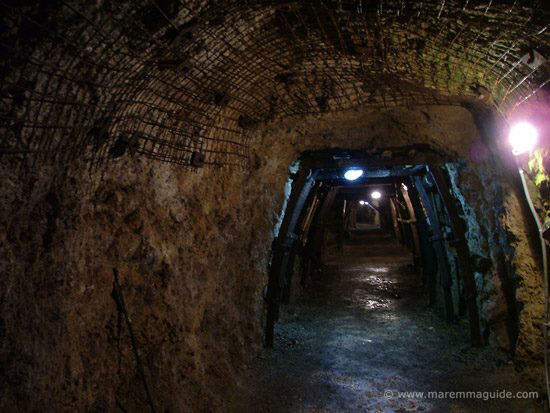
After dinner in the summer, a night-time tour of the Massa Marittima mining Museum is a perfect end of day adventure for young children that will save you from them kicking their heels at a restaurant table!
The Fortezza Orsini Museum in Sorano
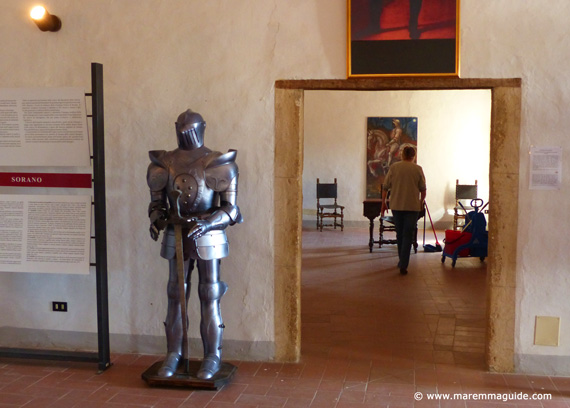
The small museum within the Orsini fortress in Sorano - called the "Museo del Medioevo e del Rinascimento" (the Middle Ages and Renaissance Museum) - is a must visit if you want a photograph of one of the very best views of the rooftops of Sorano. And, it is home to a treasure of a very special kind: the only one in the world.
It won't keep any children with you occupied for long, but a guided visit is included within the underground tour of the fortress, which they will love.
Casa Ximenes
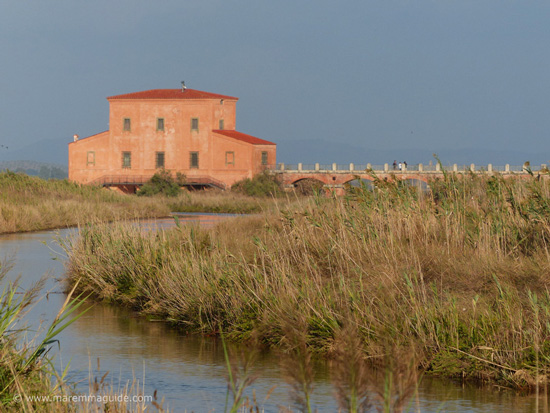
Casa Ximenes, or Casa Rossa - the Red House, as it is also known, lies just a short distance from the centre of the pretty and very popular seaside town of Castiglione della Pescaia. Yet not many weekend visitors or summer holiday makers take the scenic walk along the river Bruna to visit. But you should, if only to see the wonderful "gentleman" in the car park.
Campiglia Marittima Mineral Museum
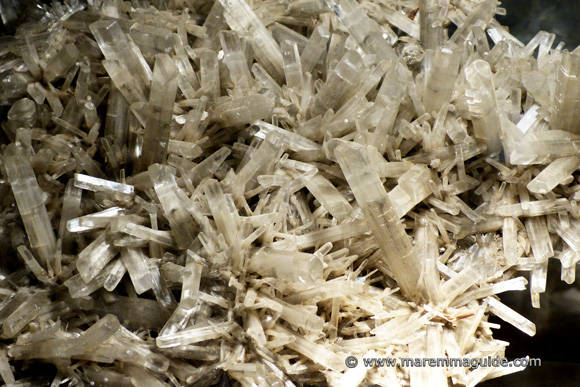
If your youngsters love sparkly minerals and those that glow in the dark - and whose don't ;) - then give them a break from following you up and down Campiglia Marittima's many wonderful medieval alleyways and take them to the town's tiny mineral museum.
The old olive oil mill in Seggiano

Even though there is a plaque on a nearby wall, nothing tells you that the worn smooth and dipping stones of the adjacent medieval alleyway - which for all intents and purposes looks to be a private access, and a dark one at that! - take you down into the 10th century bowels of this hill town. To a door behind which time has stood still. But you will need the iron key... The old olive oil mill in Seggiano.
Natural Thermal Spas
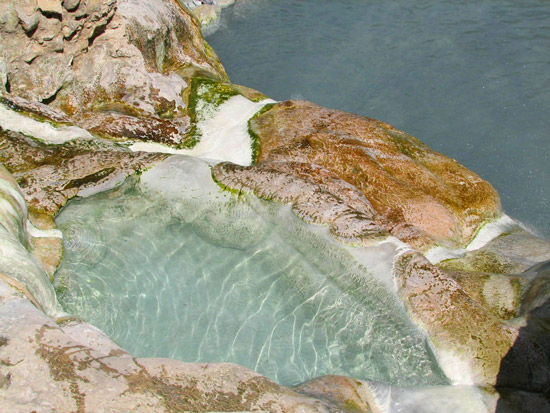 Photo by Kent & Margaret Neveu
Photo by Kent & Margaret NeveuTuscany natural thermal baths and hot springs don't come in more stunning settings than those in Maremma; after all the gods had a hand in these ;) And they are open every day of every month of the year and completely free.
Sculpture Gardens
The Tarot Garden of Niki de Saint Phalle:
Il Giardino dei Tarocchi
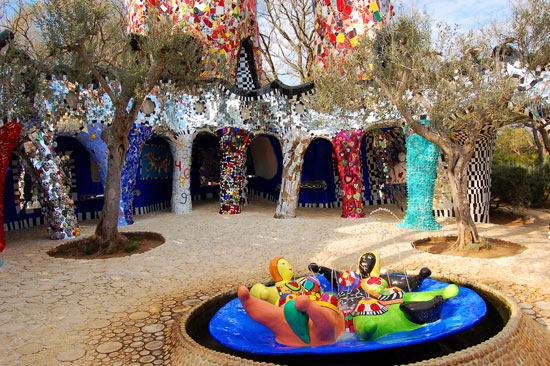 Photo by laura.laura123
Photo by laura.laura123
In a Tuscan estate at Garavicchio, near Capalbio in Maremma you will find a most unusual garden: the contemporary sculpture Tarot Garden - Il Giardino dei Tarocchi - built by French-American model, actress and artist Niki de Saint Phalle with the help of other artists and friends.
With twenty-two monumental sculptures representing the main tarot cards - the major arcana - built from welded steel bars, wire mesh, gunite cement, and mosaic ceramics and glass, Niki de saint Phalle's "garden of joy" is a truly unique experience.
www.giardinodeitarocchi.it
Places to visit in Maremma especially with children
Aquarium Mondo Marino
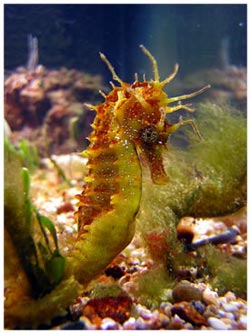
Aquarium Mondo Marino in the village of Valpiana near Massa Marittima is Tuscany's newest aquarium and is a perfect place to take the kids on a wet afternoon (or morning).
It's size might not impress when you arrive - it is small - but trust me, there are a lot of little and big fish to see and delight, positioned in tanks at heights that those with short legs can see really well.
The white shark feeding for shark enthusiasts is a must. You can even sleep-over with them!
And they now also have an outdoor dinosaur exhibition too!
La Peschiera in Santa Fiora
La Peschiera in Santa Fiora will probably already be in your list of places to visit if you are in and around Maremma's Monte Amiata territory: any of the local tourist offices will have told you about it and it is one of the most photographed locations in Santa Fiora.
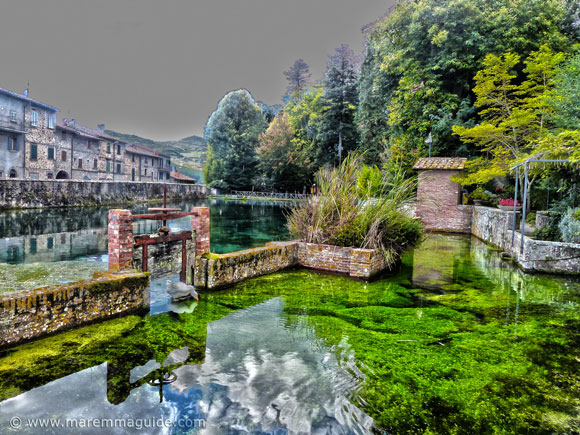
But what lies behind the two dolphins and their trident sat atop of the Peschiera's enclosing walls will surprise you and amuse for a couple of hours your children - no matter how smartphone, video games, Playstation orientated they are - in a way that you would not believe a fourteenth century fishery ever could. And all for free (well, for them anyway - it will cost cost you a whole Euro to get in!).
My daughter who, unfortunately, travels very badly and always starts asking whether we are there yet just 20 minutes or so into our journeys, will, eagerly and ever so quickly, pack her things and be found waiting at the car door to go on what is a long drive for us, to be here. Need I say more? Take your kids. You'll love it too.
Vitozza, the lost city of caves

Vitozza, the honeycomb cave city hidden in the woods. One of the world's rare and ancient cliff dwellings. With over 200 caves carved deep into tufa rock to explore and ponder on, as well as the ruins of two medieval castles, a church, a tannery, a quarry, stables and more.
And a dark trekking route that will sweep you back another nineteen centuries to 8 centuries BC. A morning or afternoon out here will well and truly make up for any history lessons that didn't inspire them. Just be ready for the questions in the car on the way back home!
Unusual things to see in Maremma
A tiny church with a floor of glass
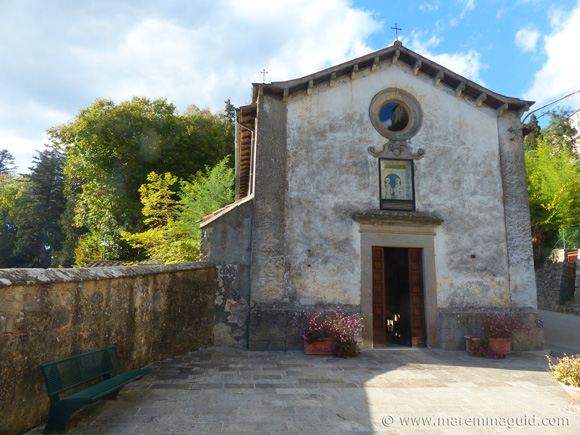
I don't usually write whole pages about a church. I'll sometimes include information about one or two if they catch my eye when I'm exploring a Maremma village or town, but not a whole page. But the tiny church of Our Lady of the Snows is different.
For one thing, it has a glass floor. Not something that you happen to find everyday in a parochial country church. But it is what lies under that glass that you should go and see.
Chiesa della Madonna delle Nevi.
Pagan mysteries, the Knights Templar trail and the Little Devil's water
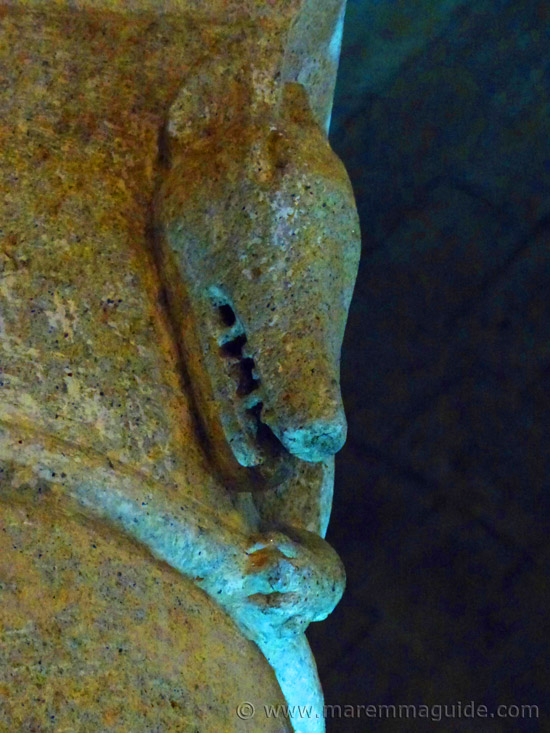
Appearances can be deceptive. And no more so than at this small church on the edges of a centuries old chestnut forest on the foothills of Maremma's Monte Amiata volcanic mountain.
You'll have to crook your neck. In the dark. To find its treasures. But they are there. And they tell of Pagan worship going way back to the 9th century. Of a Knights Templar safe haven. And hint at secrets. Hidden underground. Beneath your feet.
Just don't drink the Little Devil's water!
The Pieve di Santa Maria ad Lamulas at Montelaterone.
Middle ages art that will have you looking twice and then some!
If you are visiting Massa Marittima in the heart of Maremma - and you really should - in all probability, unless you have read a lot about the town before arriving, you will miss this unique and unusual piece of middle ages art.
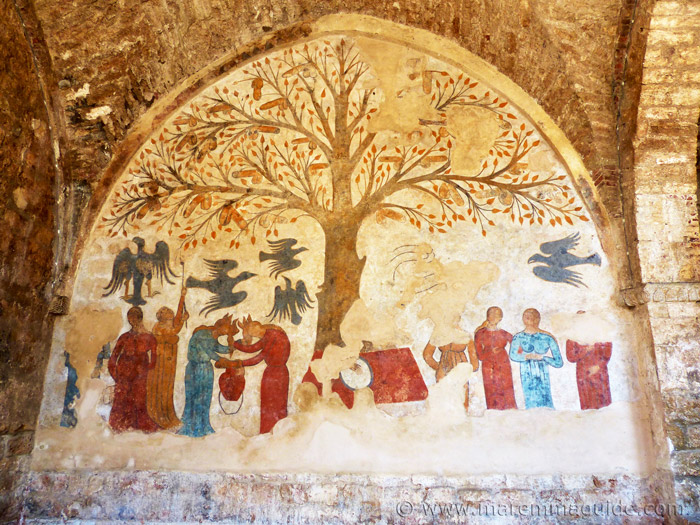
Now, before you start thinking that you don't have an interest in medieval art and will have visited enough museums for one day - there are a lot in Massa Marittima worth visiting - this particular fresco will make you look twice, then again, and again before you believe your eyes. And it is outdoors.
Interested now? Click on the link you just passed-by!
16th century graffiti that tells a story
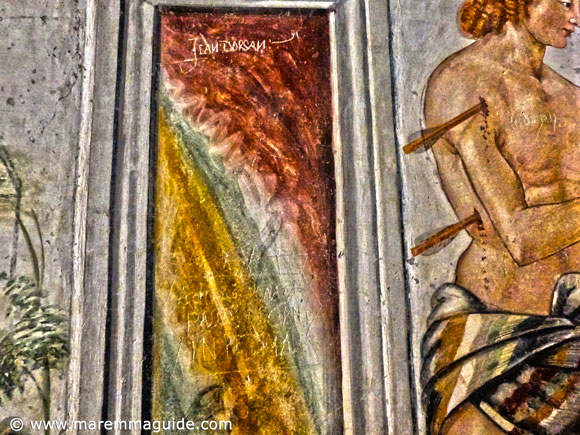
When you are stood in the same spot as the Italian, French and Spanish soldiers and mercenaries who carved their names and messages into 15th century frescoes in the tiny chapel of San Rocco in Seggiano during the Last Italian War, you will be transported back to be beside them. To a time you will be glad you never witnessed.
It's not scary - kids will be fine! - but it is a rare and special thing to see. The 16th century graffiti in the Oratorio di San Rocco.
The only olive tree in the world whose roots talk
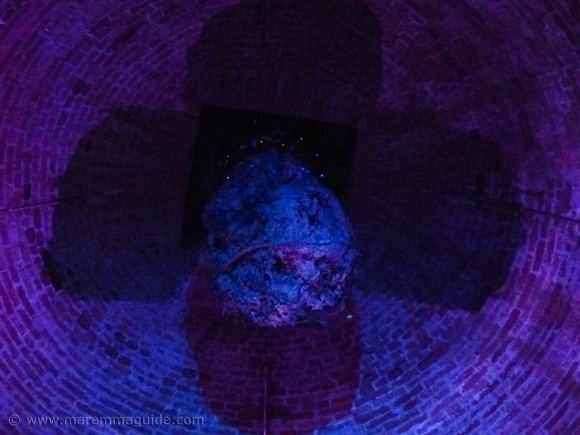
Scientists in Florence are studying how plant roots talk to other roots, roots of other plants and the incredible and fascinating "conversations" that they have. But here in Maremma, in a sleepy Tuscan hill town, planted into the roof of an ancient water cistern that forms part of this town's old city walls, is an olive tree that talks to us.
The seventy-five year old "Olivo nel Cisternone".
Choose a hill town or village to explore by walking through a Tuscany door...
If.
If you could have a key.
Just one key.
To open one door in Tuscany.
To step inside. Into whatever awaits you behind. That would be yours.
Forever.
Which door would you choose?
Only one key
There are more than 100 doors to choose from. But only one key.
Explore some more...
- Things to do in Maremma Italy
